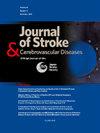脑动脉瘤线圈栓塞后再通的危险因素:第一线圈的重要性及预测模型
IF 2
4区 医学
Q3 NEUROSCIENCES
Journal of Stroke & Cerebrovascular Diseases
Pub Date : 2025-04-29
DOI:10.1016/j.jstrokecerebrovasdis.2025.108333
引用次数: 0
摘要
背景:血管圈栓塞治疗脑动脉瘤是一种成熟的治疗方法;然而,术后再通仍然存在风险。本研究旨在明确脑动脉瘤线圈栓塞后再通的危险因素,并建立评估风险的预测模型。方法回顾性研究纳入2012年至2023年在日本东京本院首次行线圈栓塞术的脑囊动脉瘤患者。排除以下病例:随访1年,再次治疗和使用生物活性线圈。结果包括动脉瘤特征和术后Raymond-Roy闭塞分类(RROC)。采用单因素和多因素Cox比例风险模型确定独立预测因子。采用LASSO logistic回归和多变量分析的β系数构建简化风险评分。内部效度通过自举重采样进行评估。使用独立队列进行外部验证,并根据区分和校准来评估模型的性能。结果150例动脉瘤患者中,按排除标准分析79例。多因素分析确定了4个独立的再通预测因素:破裂状态、动脉瘤大小≥7mm、无I级RROC和第一容积栓塞率(%)。这些变量被纳入基于整数的风险评分,范围从0到7。该模型在内部验证队列中表现出较强的判别性(C-statistic: 0.89),在外部验证队列中仍然可以接受(C-statistic: 0.81, 95% CI: 0.74-0.89)。风险分层显示,低(0-2)、中(3-4)和高风险(5-7)组的再通率分别增加1.8%、13.5%和41.5%。外部队列的校正显示,高评分患者的风险有轻微高估。结论本研究确定了线圈栓塞后再通的四个重要危险因素,并提出了一个实用的、外部验证的风险评分。该模型提供了临床相关的风险分层,并可能支持个性化的随访策略。本文章由计算机程序翻译,如有差异,请以英文原文为准。
Risk factors for recanalization after coil embolization for cerebral aneurysms: importance of the first coil and prediction model
Background
Endovascular coil embolization for cerebral aneurysms is a well-established treatment; however, postoperative recanalization remains a risk. This study aimed to clarify risk factors for cerebral aneurysm recanalization after coil embolization and to develop a predictive model for assessing risks.
Methods
This retrospective study included patients with cerebral saccular aneurysms who underwent initial coil embolization at our hospital in Tokyo, Japan between 2012 and 2023. The following cases were excluded: follow-up of <1 year, re-treatment and use of bioactive coils. Outcomes included aneurysm characteristics and postoperative Raymond–Roy Occlusion Classification (RROC). Univariate and multivariate Cox proportional hazards models were used to identify independent predictors. A simplified risk score was constructed using LASSO logistic regression and β-coefficients from multivariable analysis. Internal validity was assessed by bootstrap resampling. External validation was performed using an independent cohort and model performance was evaluated in terms of discrimination and calibration.
Results
Among the 150 patients with aneurysms, 79 were analyzed after applying exclusion criteria. Multivariate analysis identified four independent predictors of recanalization: rupture status, aneurysm size ≥7 mm, RROC without class I, and first volume embolization ratio <8 %. These variables were incorporated into an integer-based risk score ranging from 0 to 7. The model demonstrated strong discrimination in the internal validation cohort (C-statistic: 0.89), which remained acceptable in the external validation cohort (C-statistic: 0.81, 95 % CI: 0.74–0.89). Risk stratification showed increasing recanalization rates of 1.8 %, 13.5 %, and 41.5 % in low- (0–2), intermediate- (3–4), and high-risk (5–7) groups, respectively. Calibration in the external cohort showed slight overestimation of risk in high-score patients.
Conclusion
This study identified four significant risk factors for recanalization after coil embolization and proposed a practical, externally validated risk score. The model provides clinically relevant risk stratification and may support individualized follow-up strategies.
求助全文
通过发布文献求助,成功后即可免费获取论文全文。
去求助
来源期刊

Journal of Stroke & Cerebrovascular Diseases
Medicine-Surgery
CiteScore
5.00
自引率
4.00%
发文量
583
审稿时长
62 days
期刊介绍:
The Journal of Stroke & Cerebrovascular Diseases publishes original papers on basic and clinical science related to the fields of stroke and cerebrovascular diseases. The Journal also features review articles, controversies, methods and technical notes, selected case reports and other original articles of special nature. Its editorial mission is to focus on prevention and repair of cerebrovascular disease. Clinical papers emphasize medical and surgical aspects of stroke, clinical trials and design, epidemiology, stroke care delivery systems and outcomes, imaging sciences and rehabilitation of stroke. The Journal will be of special interest to specialists involved in caring for patients with cerebrovascular disease, including neurologists, neurosurgeons and cardiologists.
 求助内容:
求助内容: 应助结果提醒方式:
应助结果提醒方式:


